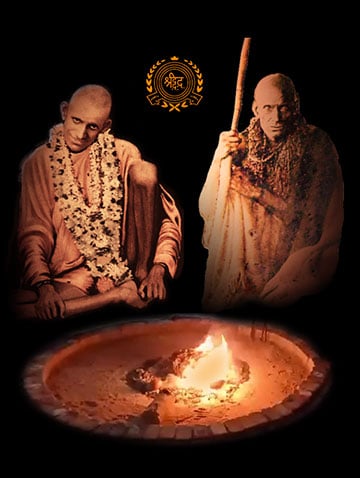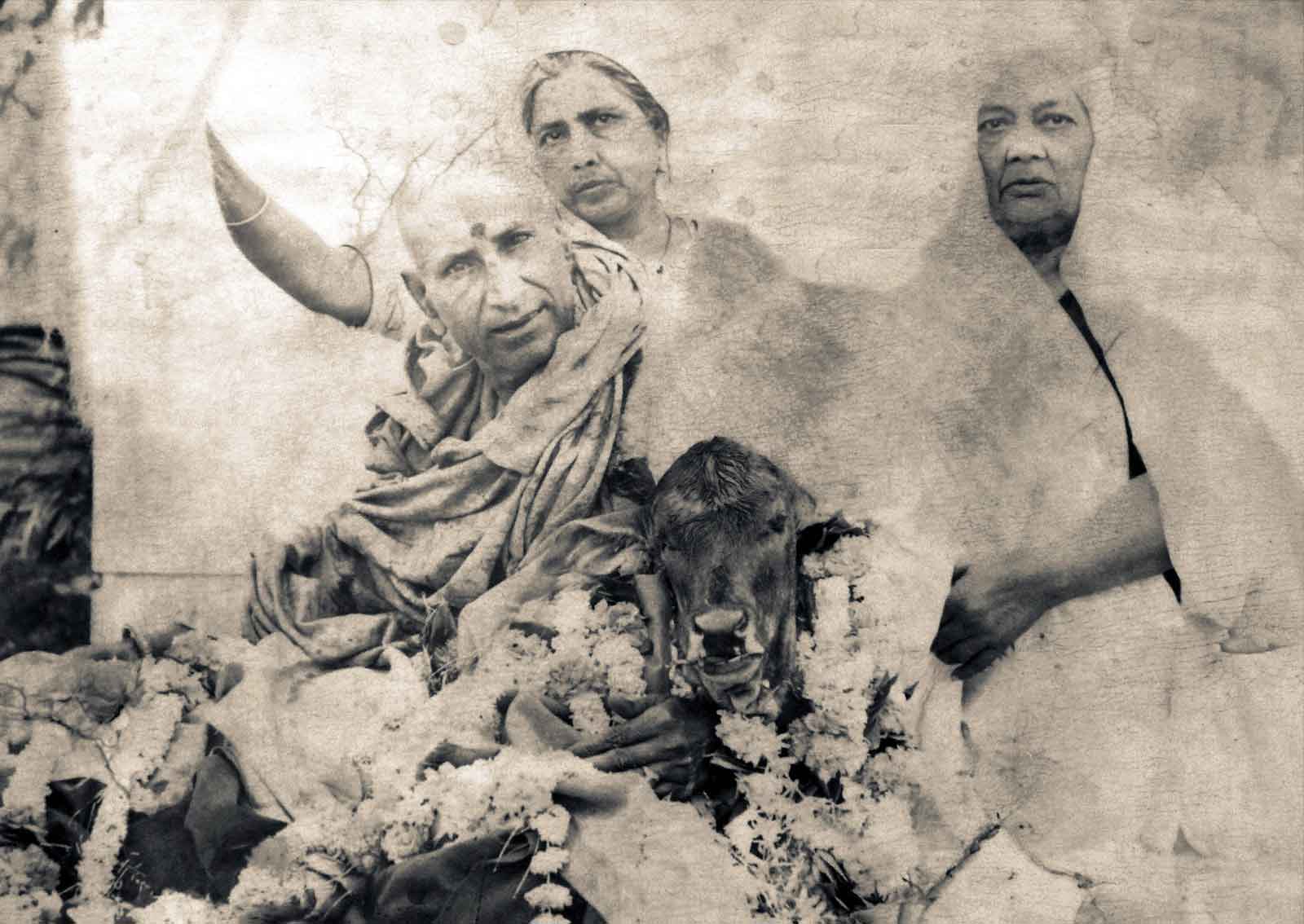Shri Ramdayalji was from a royal family in Rajasthan. His stepmother was envious of him and wanted her own son to succeed to the throne. One day she taunted him “Life is meaningless without a Guru. You should have a Guru”. Hurt by her words, Shri Ramdayalji left home in search of a Guru. He visited many saints, enlightened souls and scholars but his search did not end. One day, when he was in a temple in Badrinath he heard a voice in his head “If you think your Guru is there, then do search for him; I am here in Narmadakhand”. Being unaware of this place he asked a hermit about it, who told him that the banks of river Narmada is known as Narmadakhand and that it is very far from Badrinath. Shri Ramdayalji left for Narmadakhand immediately and reached Jabalpur on the northern bank of Narmada.
After bathing in the river and reciting his prayers he told a hermit who was sitting there about the voice that he heard in Badrinath. The hermit told him that Narmadakhand could mean either bank of the river Narmada and advised Shri Ramdayalji to read the Skand Purana (ancient holy scripture) which talks about this. When Shri Ramdayalji replied that he has already read the scripture the hermit suggested that he should start circumambulating the river. Shri Ramdayalji started walking along the bank and travelled eastward where he crossed Amarkantak (the origin of the river) and reached Sainkheda on the southern bank.
There he saw Dadaji Maharaj sitting in his congregation abusing and hitting his disciples with his stick, doing their kalyan in his own unique way (kalyan means changing their fate for the better). At that instant he felt that his search for a Guru has come to an end as he observed Dadaji from a distance. When prashad (holy food) was being served, Shri Ramdayalji extended his hands but no one served him. When the other disciples discarded their banana leaves (on which prashad is served) he touched one such leaf and put that hand on his stomach (in a way gesturing that the prashad has entered his stomach as well). Dadaji Maharaj noticed him and wondered loudly “Who is this man?”. He called him over and said “Oh so you are from Rajasthan, Oh so you are a major, Oh so you are a prince”. Shri Ramdayalji said nothing and stood there with his head bowed and hands joined in front as a sign of respect. Dadaji then told him to leave everything and join his congregation.
One day Dadaji Maharaj said to Shri Ramdayalji that from now on he should do Shri Chottey Dadaji’s seva (Seva, loosely translated means service, it’s signifies devotion of a disciple to his Guru). From that moment, Shri Ramdayalji did seva of Shri Chottey Dadaji day in and day out. He would bring firewood for Shri Chottey Dadaji to perform Havan, would tend to his Dhuni, bathe him and perform all kinds of chores. Happy with his devotion, Shri Chottey Dadaji gave him the title Indore Sarkar. Along with Dadaji Maharaj and Shri Chottey Dadaji, Shri Indore Sarkar left Sainkheda in 1930 and travelled to Chippaner, Baagli, Ujjain, Indore, Navghat Khedi, Daudvah and Khandwa.
In 1942 Shri Chottey Dadaji took samadhi at the Kumbh Mela in Allahabad. When the news of Shri Chottey Dadaji’s samadhi spread, many of his disciples packed their belongings and left. When Shri Indore Sarkarji and other remaining disciples started making preparations to take Shri Chottey Dadaji’s body back to Khandwa a few hermits and senior clergymen approached him and insisted that since Shri Chottey Dadaji has taken samadhi at the confluence of three holy rivers, his body should be immersed in the waters here (samadhi in this context means union of one’s soul with the Almighty). Shri Indore Sarkarji who firmly believed that Shri Chottey Dadaji should be taken back to Khandwa then called for Shri Chottey Dadaji’s disciple Vishwanath Choudhry, at whose residence Shri Chottey Dadaji was staying for the duration of the Kumbh. Shri Indore Sarkarji reminded Vishwanath Choudhry of an incident a few days ago where Shri Chottey Dadaji had told everyone that he will be leaving for Khandwa soon. This meant that it was Shri Chottey Dadaji’s wish to go back to Khandwa and therefore his body should be taken there. Vishawanath Choudhry then arranged for a coffin and got an additional bogey attached to the Kashi Express to take Shri Chottey Dadaji back to Khandwa. When the train arrived on the platform Shri Indore Sarkarji was extremely disappointed to see that the bogey was that of a goods train. He chided Vishwanath Choudhry for not making arrangements worthy of such a enlightened soul. Vishwanath Choudhry was very remorseful and apologised for his mistake but nothing could be changed at the last minute. Shri Indore Sarkarji said to him “Well you made a mistake, now you live with it” and he along with other disciples brought Shri Chottey Dadaji to Khandwa in the train while chanting hymns and prayers throughout the journey.
In Khandwa, Shri Chottey Dadaji’s mausoleum was built next to Dadaji Maharaj’s mausoleum. All his favourite dishes were prepared and his clothes were placed along with the body. In Hinduism, salt is not used when burying saints. In its place 21 kilograms of camphor was procured from Khandwa and nearby Indore.
Shri Indore Sarkarji stayed back in Khandwa for a few years and did seva of both the samadhis (mausoleums). During this time differences started arising among the disciples on who would succeed Shri Chottey Dadaji and this caused a lot of distress to Shri Indore Sarkarji. One disciple, Swami Charnanand felt that he should be the chosen one but others were not too keen about it. Fed up of all this, in 1948, Shri Indore Sarkarji left Khandwa and walked more than 100 Kms to Indore along the railway tracks.
In 1919, Dadaji Maharaj and Shri Chottey Dadaji had come to Chattribagh locality in Indore. At the exact location where Dadaji Maharaj’s carriage was parked there is a famous temple today, Shri Venkateshwara temple. And, as he always used to do, Shri Chottey Dadaji lit a dhuni nearby (Dhuni is a holy fire). Shri Indore Sarkarji reignited the dhuni and established the Indore Darbar.
In Indore Darbar, Shri Indore Sarkarji did severe penance by not eating anything and surviving only on water for 12 years! Any offerings that devotees would bring like clothes, food etc. he would either offer it to the Dhuni or distribute it among all the disciples. On auspicious days like Guru Purnima and other festivals he would go to Khandwa and do seva of both the samadhis. Like Shri Chottey Dadaji before him, royals such as Maharaja Jai Singh of Jaipur, Virendra Bahadur Singh of Sohawal and others made him their Guru.
He would travel to Khandwa often to do seva at both the samadhis and help out in the running of Khandwa Darbar (seva means service).
During one such visit, coincidentally he happened to meet the chief minister of Madhya Pradesh, Bhagwant Rao Mandloi at the railway station and appraised him of the situation at Khandwa Darbar. The CM asked Shri Indore Sarkarji if he could be of any service. On Shri Indore Sarkarji’s suggestion he initiated the formation of a trust which came into being in 1962. When the trust was being formed, Shri Indore Sarkarji insisted that Swami Charnanand, being a brahmin, should be made a trustee which did not go down well with the other trustees and it sowed the seeds of discontentment.
At the age of 105, on 18th February 1989, Shri Indore Sarkarji took samadhi. His successor Shri Chottey Sarkarji made his samadhi in Indore Darbar where devotees from all over the world still come and pay homage.

